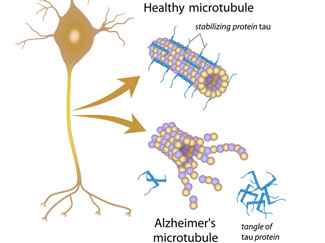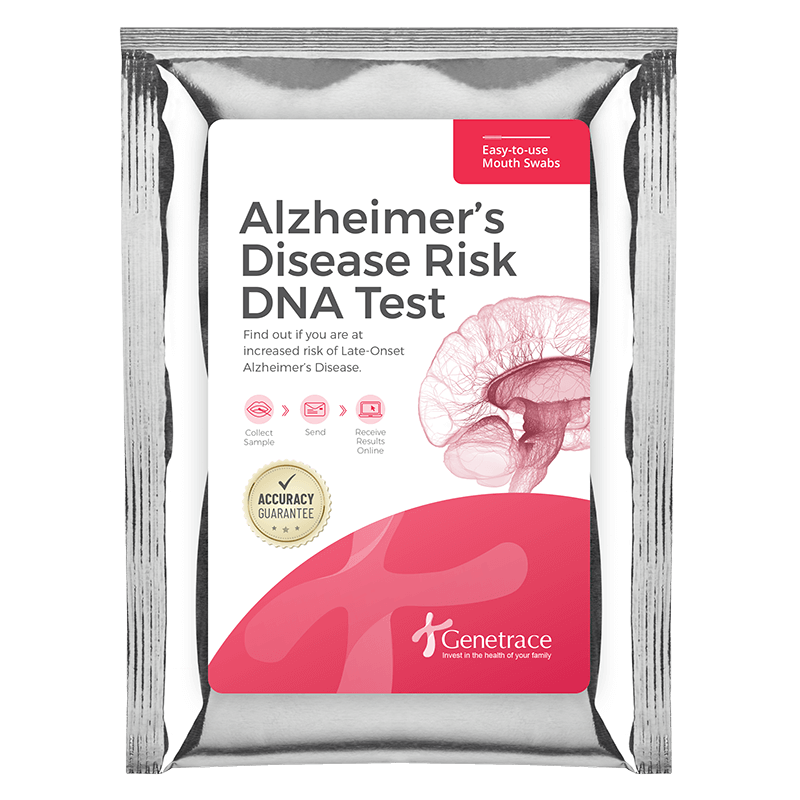About the Disease
What is Alzheimer’s Disease?

Find out if you are at risk - get tested
| Test Type | Testing Time | Fee |
|---|---|---|
 DNA Alzheimer's Disease Test
DNA Alzheimer's Disease Test
| 4 to 6 weeks |
$195
Click Here to Order Kit |
All orders received before 3pm PST / 6pm EST are shipped out the same business day. All orders received after 3pm PST / 6pm EST or on weekends or holidays are shipped out the following business day. 24/7 online status check and account management available for all tests.
What is Alzheimer’s Disease?
Alzheimer’s disease is a progressive brain disorder characterized initially by memory loss and later by the loss of thinking, reasoning and behavioral abilities. Alzheimer’s is the most common cause of dementia accounting for 50 – 75% of approximately 44 million dementia cases worldwide in 2015. There are both early-onset and late-onset forms of the disease, with the late-onset form of Alzheimer’s occurring in more than 90% of cases. The lifetime risk of getting Alzheimer’s is estimated at 10 – 12% and for those individuals who have a family member with late-onset dementia; the risk increases to 15 – 30%. The prevalence of dementia and, in particular, Alzheimer’s increases with age with an estimated 25 – 45% of persons over 85 years suffering from some form of dementia.
What Causes Alzheimer’s Disease?
The causes of Alzheimer’s disease are not fully understood. In the small number affected by the early-onset form, a genetic mutation is usually the cause and this disease tends to cluster within families. The more common late-onset form occurs due to changes in the brain that occur over decades. These changes likely occur due to a combination of genetic, environmental and lifestyle factors. One gene in particular, APOE, is the biggest genetic risk factor linked to the late-onset form.
Genetics of Alzheimer’s Disease
Apolipoprotein E is involved in injury repair and transporting fats between brain cells. There are three main forms or alleles of APOE – APOE e2, APOE e3 and APOE e4. Individuals with one copy of the APOE e4 have three times the risk of developing late-onset Alzheimer’s, while those with two copies of APOE e4 have 10 – 15 times the risk. APOE e2 appears to be protective against Alzheimer’s. Genome-wide association studies have recently identified several other genes that may also be linked to late-onset Alzheimer’s disease. These include CLU (regulates the clearance of amyloid-beta), CR1 (controls brain inflammation), and PICALM (helps neurons communicate). None of these other genes influence the risk of Alzheimer’s as much as the APOE e4 allele.
Other Risk Factors for Alzheimer’s Disease
Although the presence of the APOE e4 allele is strongly associated with an increased risk of Alzheimer’s, current research shows that several other factors may also play a role. There appears to be a link between cognitive decline (e.g. dementia) and vascular conditions (e.g. heart disease) and metabolic conditions (e.g. diabetes). Ongoing research is investigating whether reducing the risk factors for these other diseases will also reduce the risk of Alzheimer’s.
There are six important factors that have been associated with staying healthy as people age. These are a nutritious diet, physical activity, social engagement, mental stimulation, adequate sleep and good stress management. These same factors may also help reduce the risk of Alzheimer’s disease and other forms of dementia.
Increased Risk with Associated Disorders
Alzheimer’s disease occurs in most people that have Down syndrome. This may be due to the presence of an extra chromosome 21 that contains the gene that generates amyloid resulting in the harmful amyloid plaques in the brains of Alzheimer’s patients. People that suffer from mild cognitive impairment (MCI) are also at a higher risk of developing Alzheimer’s disease.
Other Types of Alzheimer’s Disease and Dementia
The most common form of Alzheimer’s disease is the late-onset form. However, a small percentage (2 – 10%) suffers from an early-onset form of the disease, where the first symptoms appear between 30 and 60 years of age. Most of the early-onset cases occur in family clusters and are known as familial Alzheimer’s disease (FAD). Early-onset Alzheimer’s is often caused by mutations in one of three genes – amyloid precursor protein (APP), presenilin 1 (PSEN-1) or presenilin 2 (PSEN 2).
Alzheimer’s is the predominant form of dementia accounting for 50-75% of the approximately 44 million dementia cases worldwide in 2015. Other forms of dementia include Lewy body dementia, frontotemporal disorders and vascular dementia. It is common for people to have mixed dementia, where they suffer from two or more disorders. Every year, there are 4.6 million new cases of dementia and the total number affected is expected to double by 2030.
